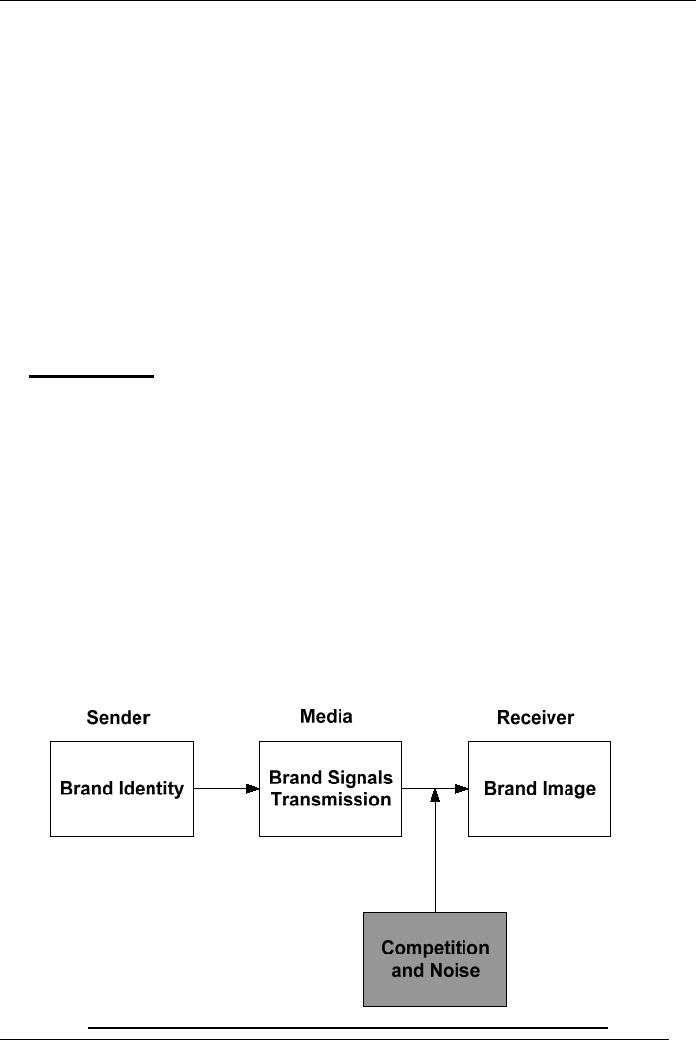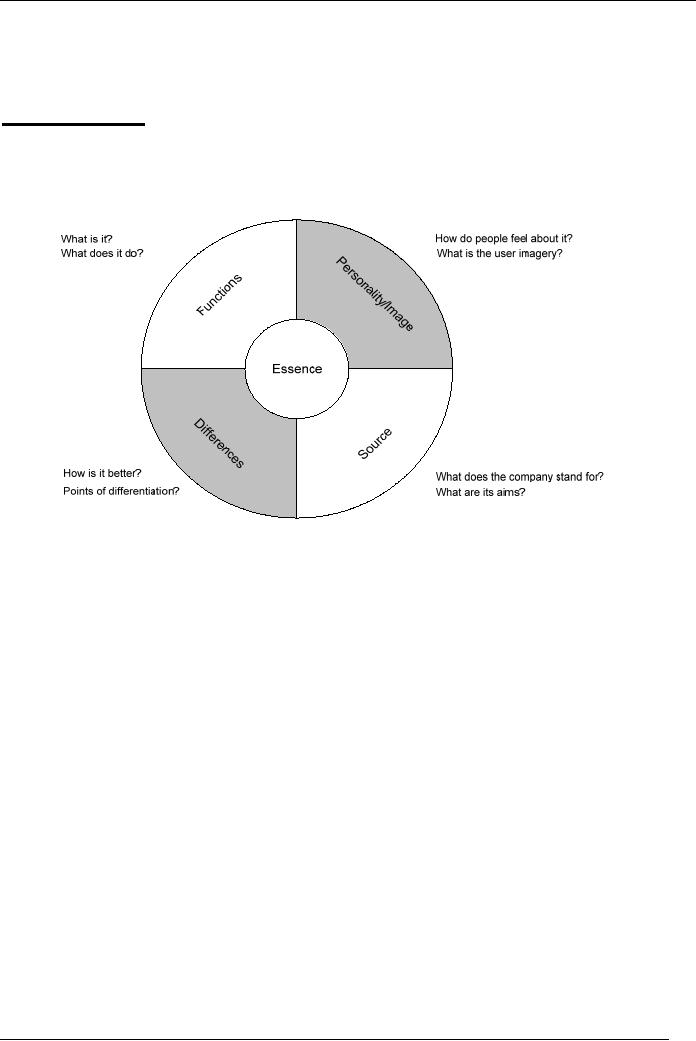 |

Brand
Management (MKT624)
VU
Lesson
3
BRAND
MANIFESTATIONS/ FUNDAMENTALS
To
manage your brand as an
asset, full of value and power,
you must understand a
few
fundamentals
that form the basis of
brand asset management.
Armed with that
understanding,
you,
as brand managers, will do your job
right only if you understand
brands correctly.
The
following four fundamentals will
allow you to develop with
ease and consistency
the
ability
to build different strategic
steps involved in creating a
brand or refreshing an
existing
one.
�
Dimensions
�
Characteristics
�
Levels
�
Brand
Owners' Commitment
Foreword
to Brand Dimensions
For
comprehension of a brand's dimensions,
three models are fundamental
to any discussion
about
the subject. That is the
first and the foremost thing
you have to keep in your
mind. Those
are:
�
Brand
identity
�
Brand
image
�
Communication
Brand
identity: Brand
identity is what a company
transmits about the brand to
the market
place.
Identity has many components
the name, the packaging,
the colors, the
typestyle,
the
logo, and a host of other
factors that comprise its
personality. The personality of a
brand
should
be created for it to get expressed in
terms of well-defined characteristics.
For
example,
reliable, friendly, durable, and serious
etc.
What
is most important here is that
the company must be able to
express the real essence
of
the
product to the target
market. Any product, however
high on the quality and
reliability
grid,
may not exploit its full
potential if it is not expressed
right by way of creation of
the
right
compatible personality.
If
a brand is to be registered in the minds
of consumers as "durable", then
the whole
identity
has to revolve around the
aspects of durability. You must
not develop a package
and
related components that
convey a sense of "fashionableness".
That will be contrary to
the
personality/identity of the
brand.
Brand
image: Brand image
is a term used very loosely
by people outside the sphere
of
marketing.
Changing the image is a favorite
topic while discussing brands
under distress.
But
image is not something that can be
changed or transformed with the
speed we change a
color
on the drawing board.
Brand
image follows identity. It is a
reflection of what we projected to
send to the public.
Managers
must be clear about what
they want to send and how
they want it received.
Brand
image,
then, is something that
builds into the minds of
the consumers.
To
what extent that image is in
line with the identity
created by the company is
the greatest
challenge
for brand managers! The more
the managers can have the
market imagine their
brand's
identity the way it is
intended to be imagined, the
more successful they are in
their
effort.
If there is a gap between
the identity and the image,
then there is a need
for
corrective
action.
11

Brand
Management (MKT624)
VU
Companies'
efforts to build the right
image span so many different
means of
communication
of which brand's own
appearance is a part. Brand
image, therefore, is
the
totality
of information, advertising, promotions,
and other brand manifestations
that the
consumer
has seen and received about
the brand over a period of
time. It is, in other
words,
his
experience with the brand
modified by certain perceptions,
previous beliefs,
biases,
social
norms, and a level of
forgetfulness1.
Due
to a finite level of information
retention in human mind
coupled with the fact
that other
variables
mentioned above modify perceptions,
the image on the consumer's
side may not
be
100% identical with the
identity. The reasons can be
clarified with the help of
the
following
explanations:
�
Your
inability to continuously advertise
may become one factor
putting your brand
out
of the mind of the
consumer.
�
Your
bias about the origin
(from a certain geographic
area) of the product
may
change
the product's image in your
mind.
�
Your
beliefs about the way a
product should or should not
be used may affect
product's
image.
Communication:
The
vehicle that transmits
brand's identity to the
target market for
creation
of the right image is communication. To
ensure that image remains as close
to
identity
as possible, companies get into communications of
different kinds. This is
where
brand
communication takes an important
stage. Correct communication
goes a long way in
creating
and building brand
identity.
In
the words of Philip Kotler,
"communication is an interactive dialogue
between the
company
and its customers that takes
place at the pre-selling, selling,
consuming, and post-
consuming
stages"2 This
implies that communication is a
recurring process that
starts
before
you buy (advertising,
promotions, and other), remains in
force while you buy
(the
brand
itself communicates), and does
not end even after you
have consumed the
brand
(brand's
ability to satisfy you keeps
reminding you of being loyal
to it). It goes on and
on.
It
further means that
communication is not restricted to
the traditional
communication
platform,
which is advertising, promotions,
public relations, personal
selling, and also some
technologically
advanced ways of reaching the
consumers through e-mail and
internet-
based
direct marketing. The
working of three models can be
graphically illustrated as
follows:
Figure
6
Source:
Jean-Noel Kapferer: Strategic
Brand Management; Kogan
Page
12

Brand
Management (MKT624)
VU
All
components of brand's personality
discussed earlier also form
brand contact points
that
strengthen
or weaken customers' view of
the brand, and, hence, work
as brand communicators.
We,
as brand managers, have to assess
which impressions can influence
the customer's buying
process
more so that we can direct
our communication toward
that point.
Brand
Dimensions
Having
understood the three models,
namely, brand identity,
brand image and communication,
we
can go ahead with our
discussion of the dimensions of brands,
which is graphically
represented
hereunder:
Figure
7
13

Brand
Management (MKT624)
VU
Functions:
Every
brand has a reason for
being. If managers have
correctly created a
brand
that
fulfills a particular "need" in a
convincing way, then their
understanding of the brand
is
clear
about what function the
brand is going to
fulfill.
Functions,
therefore, stand for the
central purpose of a brand. Why it exists?
What need(s) it
fulfills?
Whose need (target market)
it fulfills? Starting point in
the process of brand
development,
the functions are carefully
studied before making the
decision for brand's
introduction.
Management must be clear
about the value the
brand is going to offer
its
customers
and the value it will generate
for the company.
Differentiation:
In
order to fulfill a certain
need, a brand has to have a
certain level of
differentiation,
which refers to different and
extra features. It is these
extra features that
attract
your target and offer them
value.
In
the age of fierce
competition, the comparison is
not between products that
are perceived
as
"passed products" and "failed
products". The competition is
among excellent
products.
According
to Kapferer, some brands (products)
are "more excellent" than
others.
Differentiation
can take so many shapes and forms.
Apart from extra physical
attributes of a
brand,
differentiation may also take place in
terms of creative distribution
channels and
promotions.
The
source: The source
company is important in terms of
its reputation. Consumers as
well
as
trade members who play an important
role in promoting brands to consumers
gauge
commitment
of producers that they may
have with their brands in
light of their
reputation,
history,
and image in the market
place.
Two
brands of equally good quality by two
different companies may not
enjoy the same
level
of following and loyalty. The one
offered by a company with
strong reputation in
all
probability
will have a better chance of gaining a
wider customer base.
Businesses must
carefully
consider this source dimension to
continually improve their
reputation and
leverage
their brand(s).
Personality/Image:
Personality
and image have been discussed in
detail as part of
identity
and
image models and offer themselves as
very important dimensions of
any brand
management
effort.
The
reason for a separate
discussion on identity and image models
ahead of discussion on
dimensions
stems from the fact
that they are always at
the center of any overall
dimensional
model
that may be described
differently from the one above.
Actually, different
authors
have
explained the dimensional
model in different ways with
terminologies different
from
the
four dimensions explained
above. To understand any
models, an understanding of
identity
and image must take precedence over
anything else.
What
is of significance is that all
the dimensions around the
essence have to be consistent
and
they
must complement each other.
The more consistent they
are the stronger is the
essence and
the
brand identity.
14

Brand
Management (MKT624)
VU
Glossary
of terms
Direct
marketing: A direct marketing
system is an interactive system
without the help of any
intermediaries.
The seller seeks direct
orders from buyers who are
influenced by one or more
advertising
or promotional media.
Brand
contact points: All those
functional areas that interface
with that of brand
management,
namely
finance, production, purchasing and
supply chain, human resources, and
information
systems
and technology to name the major
ones.
Bibliography
1.
Geoffrey Randall: "Branding A
Practical Guide to Planning
your Strategy"; Kogan
Page
(6)
Other
suggested readings
Jean-Noel
Kapferer: "Strategic Brand
Management"; Kogan Page
(90-119)
15
Table of Contents:
- UNDERSTANDING BRANDS – INTRODUCTION:Functions of Brand Management, Sales forecast, Brand plan
- INTRODUCTION:Brand Value and Power, Generate Profits and Build Brand Equity
- BRAND MANIFESTATIONS/ FUNDAMENTALS:Brand identity, Communication, Differentiation
- BRAND MANIFESTATIONS/ FUNDAMENTALS:Layers/levels of brands, Commitment of top management
- BRAND CHALLENGES:Consumer Revolt, Media Cost and Fragmentation, Vision
- STRATEGIC BRAND MANAGEMENT:Setting Objectives, Crafting a Strategy, The Brand Mission
- BRAND VISION:Consensus among management, Vision Statement of a Fast Food Company, Glossary of terms
- BUILDING BRAND VISION:Seek senior management’s input, Determine the financial contribution gap
- BUILDING BRAND VISION:Collect industry data and create a brand vision starter, BRAND PICTURE,
- BRAND PICTURE:Brand Value Pyramid, Importance of being at pinnacle, From pinnacle to bottom
- BRAND PERSONA:Need-based segmentation research, Personality traits through research
- BRAND CONTRACT:The need to stay contemporary, Summary
- BRAND CONTRACT:How to create a brand contract?, Brand contract principles, Understand customers’ perspective
- BRAND CONTRACT:Translate into standards, Fulfill Good Promises, Uncover Bad Promises
- BRAND BASED CUSTOMER MODEL:Identify your competitors, Compare your brand with competition
- BRAND BASED CUSTOMER MODEL:POSITIONING, Product era, Image Era, An important factor
- POSITIONING:Strong Positioning, Understanding of components through an example
- POSITIONING:Clarity about target market, Clarity about point of difference
- POSITIONING – GUIDING PRINCIPLES:Uniqueness, Credibility, Fit
- POSITIONING – GUIDING PRINCIPLES:Communicating the actual positioning, Evaluation criteria, Coining the message
- BRAND EXTENSION:Leveraging, Leveraging, Line Extension in detail, Positive side of line extension
- LINE EXTENSION:Reaction to negative side of extensions, Immediate actions for better managing line extensions
- BRAND EXTENSION/ DIVERSIFICATION:Why extend/diversify the brand,
- POSITIONING – THE BASE OF EXTENSION:Extending your target market, Consistency with brand vision
- DEVELOPING THE MODEL OF BRAND EXTENSION:Limitations, Multi-brand portfolio, The question of portfolio size
- BRAND PORTFOLIO:Segment variance, Constraints, Developing the model – multi-brand portfolio
- BRAND ARCHITECTURE:Branding strategies, Drawbacks of the product brand strategy, The umbrella brand strategy
- BRAND ARCHITECTURE:Source brand strategy, Endorsing brand strategy, What strategy to choose?
- CHANNELS OF DISTRIBUTION:Components of channel performance, Value thru product benefits
- CREATING VALUE:Value thru cost-efficiency, Members’ relationship with brand, Power defined
- CO BRANDING:Bundling, Forms of communications, Advertising and Promotions
- CUSTOMER RESPONSE HIERARCHY:Brand-based strategy, Methods of appropriations
- ADVERTISING:Developing advertising, Major responsibilities
- ADVERTISING:Message Frequency and Customer Awareness, Message Reinforcement
- SALES PROMOTIONS:Involvement of sales staff, Effects of promotions, Duration should be short
- OTHER COMMUNICATION TOOLS:Public relations, Event marketing, Foundations of one-to-one relationship
- PRICING:Strong umbrella lets you charge premium, Factors that drive loyalty
- PRICING:Market-based pricing, Cost-based pricing
- RETURN ON BRAND INVESTMENT – ROBI:Brand dynamics, On the relevance dimension
- BRAND DYNAMICS:On the dimension of knowledge, The importance of measures
- BRAND – BASED ORGANIZATION:Benefits, Not just marketing but whole culture, Tools to effective communication
- SERVICE BRANDS:The difference, Hard side of service selling, Solutions
- BRAND PLANNING:Corporate strategy and brands, Brand chartering, Brand planning process
- BRAND PLANNING PROCESS:Driver for change (continued), Brand analysis
- BRAND PLAN:Objectives, Need, Source of volume, Media strategy, Management strategy